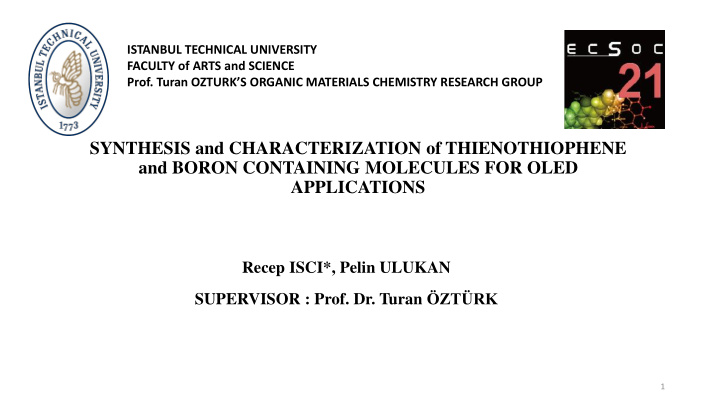



ISTANBUL TECHNICAL UNIVERSITY FACULTY of ARTS and SCIENCE Prof. Turan OZTURK’S ORGANIC MATERIALS CHEMISTRY RESEARCH GROUP SYNTHESIS and CHARACTERIZATION of THIENOTHIOPHENE and BORON CONTAINING MOLECULES FOR OLED APPLICATIONS Recep ISCI*, Pelin ULUKAN SUPERVISOR : Prof. Dr. Turan ÖZTÜRK 1
21th International Electronic Conference on Synthetic Organic Chemistry (November 2017) ECSOC-21 Organic Light Emitting Diodes An OLED is made by placing a series of organic thin films between two conductors. When electrical current is applied, a bright light is emitted. 2
21th International Electronic Conference on Synthetic Organic Chemistry (November 2017) ECSOC-21 OLED Structure 1.attach a voltage (potential difference) across the anode and cathode. 2.As the electricity starts to flow, the cathode receives electrons from the power source and the anode loses them (or it "receives holes," if you prefer to look at it that way). 3. added electrons are making the emissive layer negatively charged (similar to the n-type layer in a junction diode), while the conductive layer is becoming positively charged (similar to p-type material). 1.Positive holes are much more mobile than negative electrons so they jump across the boundary from the conductive layer to the emissive layer. When a hole (a lack of electron) meets an electron, the two things cancel out and release a brief burst of energy in the form of a particle of light — a photon , in other words. 3
21th International Electronic Conference on Synthetic Organic Chemistry (November 2017) ECSOC-21 THIENOTHIOPHENES Luminescence, Rich in sulfur. Fluorescence, Photochromism, Good electron donors. Nonlinear optic, Good electron delocalization. Transistors, Building block of many electronic and Capacitors, Conductive Polymers, optoelectronic materials. Charge Transfer Complexes, OLEDs, Photovoltaic Cells. Mabkhot, Y.N., Al-Majid, A.M., Alamary, A.S., Warad, I., Sedigi, Y. (2011) Reactions of Some New Thienothiophene Derivatives. Molecules. 16 :p. 5142-5148. 4
21th International Electronic Conference on Synthetic Organic Chemistry (November 2017) ECSOC-21 Synthesized OLED Molecules 5
21th International Electronic Conference on Synthetic Organic Chemistry (November 2017) ECSOC-21 Experimental • Initially , we started our synthesis with the monoketone reactions. Then we have synthesized our thienothiophene product which is the ring closure step. Then, we did the selectively bromination reaction in order to get the target molecule 5. We have brominated our product in order to make it ready for the suzuki coupling reaction in the next step. 6
21th International Electronic Conference on Synthetic Organic Chemistry (November 2017) ECSOC-21 Experimental • In order to get our target molecule, we have reacted our brominated TT molecule with the reactant 6, and we have obtained the product 7 which is the TT-TPA molecule. Then, in the last step we reacted our molecule with dimesityl boron fluoride and we got the product 8. 7
21th International Electronic Conference on Synthetic Organic Chemistry (November 2017) ECSOC-21 Results QY: Quantum Yield 8
21th International Electronic Conference on Synthetic Organic Chemistry (November 2017) ECSOC-21 Results Scheme : UV-Visible and Fluorescence graphs in THF and in solid state respectively. 9
21th International Electronic Conference on Synthetic Organic Chemistry (November 2017) ECSOC-21 Results Scheme : UV-Visible and Fluorescence graphs in THF and in solid state respectively. 10
21th International Electronic Conference on Synthetic Organic Chemistry (November 2017) ECSOC-21 Results max[a] max[b] max[c] max[d] Madde [nm] [nm] [nm] [nm] R= F 406 520 421 498 404 R= CN 416 543 519 [a] Absorption maximum in THF. [b] Emission maximum in THF. [c] Solid state absoption maxium. [d] Solid state emission maximum. 11
More recommend